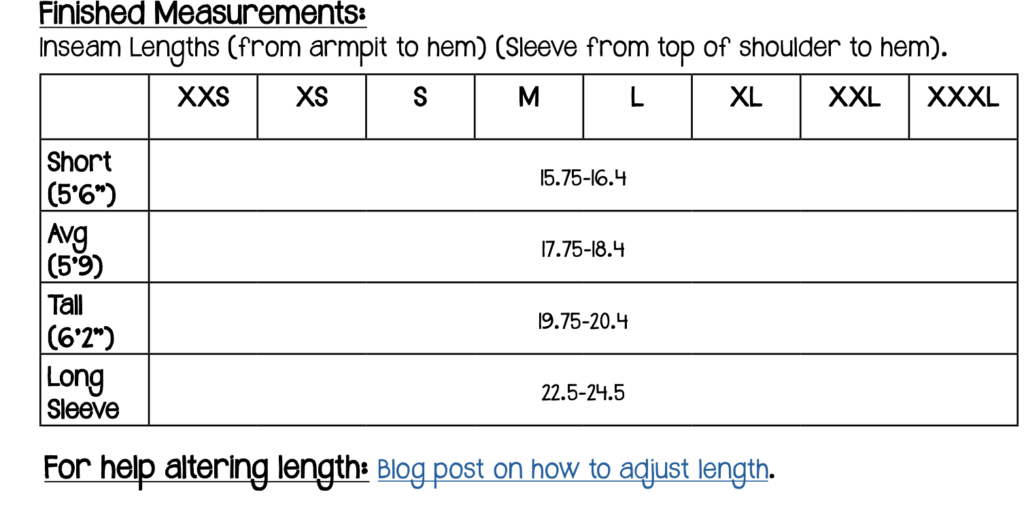
The next of Dave’s Christmas gift garments is a Patterns for Pirates men’s Henley T-shirt. This is actually a selfish sew because I love how good he looks in a Henley. Also, I’ve never sewn one so it seemed a good opportunity to learn a couple of new skills. Knit necklines are a mystery to me, and the placket neckline would, hopefully, be a fun challange.
Patterns for Pirates (P4P) is a new to me pattern company. I had heard of them but never tried them. Men’s patterns are thin on the ground. Men’s patterns to fit these shoulders even more so. I had planned on making Thread Theory’s Strathcona Henley, but it only fits up to a 44″ chest.
So, I did a quick Google search, and found P4P. This was the only men’s Henley I could find that was drafted for larger sizes, but which also had agreeable style proportions. I felt that $9 seemed a reasonable price to pay to explore this new brand.
Grab a beverage. This is a long one!
The men’s Henley pattern also includes a round neck, a hoodie option, different hem and cuff finishes and several sleeve and body length options.
However, the price point should have been a big red flag that there’d be some issues.
I have to say that I was pleased with the no-trim PDF. Unlike other no-trims I’ve tried, this one has guide lines to help you quickly and easily tape this together. I’ve never got a pattern from printer to ready to cut so quickly. Only one line on the upper arm was slightly off, and it was so slight as to not be a problem for cutting out.
I did note that all the lines and text seem really heavy, so that might have impacted. Also, they use more ink than is necessary.
One other point is that the standard markings aren’t used, for example at the fold, and there are no notches to match pieces.

I measured a favourite Henley of Dave’s. Although the pattern instructions for the men’s Henley state that based on his body measurements he’s a size xxxl, the xxl size is almost an exact match for the RTW. So I cut out the xxl without any alterations whatsoever.
At this point I’d like to talk a bit about the instructions. Spoiler alert: I don’t like them as much as the PDF.

I found the font to be a bit twee for my taste. Also, a bit of white space and a cleaner font would make reading all of this so much easier…especially if you don’t want to print the instructions but want to read them on your phone. I have the one of the large iPhones and reading on it isn’t usually a problem, but it is with this text.

The finished measurements chart isn’t clear and only gives lengths, not circumferences.

I really loathe that the fabric requirements are only in imperial, and that I have to work out the totals. I also can’t see how you need the same amount of fabric for an xxs as you do for an xxxl, so I can imagine that if you’re making the smaller size there’s going to be wastage.
The pattern also has cut lines for short, average and tall. There is a 4″/10cm difference between short and tall. That’s 8″ or 20cm over the two pieces, front and back. £2.50’s worth of this fabric. So again, a tall xxxl will use more fabric than short xxs, so even more wastage.
I find this really frustrating given the current dialogue around wastage in fabric production and wastage in scraps. If the pattern designer isn’t going to do the work, you can’t do so until after you’ve bought the fabric, which feels disingenuous to me.
Also, I cut the xxxl long. I had purchased 1.5m of fabric. The pattern states 1 7/8th yard of fabric, equivalent to a little over 1.7m. I was just 20cm short of the recommended quantity.
All pattern pieces are cut on the fold. I managed to eke the front, back and sleeves out of 1.5m of fabric but folding each side into the centre to give me two fold lines on which to cut. The collar band was cut from scraps because I had sufficient stretch in the fabric to do so.

Nowhere in the instructions is a cutting layout or cutting instructions given. I really feel that this is something that a beginner wouldn’t know how to do, and would blame themselves for not getting sufficient fabric. Or they’d buy more and waste a significant amount.
My cutting layout saved me £2.50’s worth of fabric alone. About 12.5% of the total cost of this fabric. Had I cut the short version I could have saved £5.00. These are not insignificant amounts if you can make these savings on every garment you sew.
Also, there is no layout for taping the pattern together, which is common in every other PDF pattern I’ve purchased.
I did wonder why the layouts hadn’t been included, but it became clear as I worked through the instructions.

I HATE photo instructions.
There is a whole army of “indie” pattern companies, particularly for children’s patterns, who use photos for instructions. I do understand that Illustrator isn’t something everyone can do, but it can be outsourced.
It’s very frustrating. Especially as for this pattern, there is no consistency in the photos. I counted 5 different garments photographed for the instructions, rather than one. It’s very jarring.
One other pet peeve. The sleeve is printed as a half sleeve, cut on the fold. This tells me that the usual differential in shaping between the front and back of the sleeve is missing. Also, I personally prefer to have the full sleeve pattern so I can cut both sleeves at the same time rather than individually.
By the time I’d got to cutting out the fabric I knew that I wouldn’t be buying from this brand again.
I know that the options for men’s sewing patterns are limited, but I think I’d rather draft from scratch than buy from this brand. It just feels like a throwback to a few years ago, before the indie brands such as Helen’s Closet and Closet Core upped the game in terms of product, and the recent changes in inclusivity in sizing in women’s wear.

Dave’s a big chap who was a firm favourite on the rugby field. Still, he can easily shop the high street in RTW, something I can’t do with the same ease. But in sewing patterns he’s excluded, or we need to trade quality of product for access.
It’s a really poor show.
Thankfully the fabric is delicious. It’s a gorgeous army green jersey from the lovely Minerva. I chose this to go with the sweat-shirting I used for the joggers and as a nice, but subtle, change from the usual greys, blues and blacks that Dave favours. He likes it and it suits him.

It has the perfect weight and drape. It’s lighter weight than the John Kaldor I used for the Blackwood cardigans, but is just the ticket for a t-shirt. I’m very fussy about t-shirt fabric for myself. I need drape, but not cling. This is a fabric that I’d try out for myself for a t-shirt. Maybe get around to finally sewing the Cashmerette Concord I’ve been promising myself for forever.
There are some fitting issues around the armhole, which as discussed above, I’d expected due to the drafting of the armhole. Also some due to the breadth of shoulders on my man.


Firstly, the armhole is to short. I need to drop it a good couple of centimetres to remove all the dragging around the armhole.
The shoulder is also too wide at the back. If I pinch out a wedge of fabric from the centre of the shoulder seam all the way down the back to the hem, the back shoulder and sleeve sit better. Also the shirt then fits the triangular shape of Dave’s torso, removing excess at the waist as you go. Dave also feels this is about an inch too long, so that’s an easy fix.
I need to pin all of this out on this garment, transfer the adjustments to the pattern and try again. This is, effectively a very wearable muslin.

However. This fits better than his ready to wear henley’s and is in constant rotation. So although there are some issues, he’s a happy chap!
One word of caution. I used self fabric for the placket. Although the placket is easy to sew, my machine did not like the bulk of it at all, and I had to borrow a machine to get the buttonholes in. The instructions for making the placket do tell you to use a thinner fabric and it’s good advice.

When I make this again, I’ll order a fat quarter of matching cotton fabric, or use a thinner jersey overall.
So whilst I’m not a fan of Patterns for Pirates instructions, and feel the drafting of this is a little basic, it does give me a reasonable base to work from, adjust and create the perfect henley pattern for Dave. Not bad for £9.
Despite the issues you had with the pattern instructions, this looks great already and, once you’ve adjusted it to your liking, the next one will be perfect.
I don’t think the price point should be an excuse for a less than perfect pattern – there will always be willing testers who should be able to highlight any faults before production.
Thank you. I think it’s nearly there.
I agree about the price point….but I do think it’s a bit “fangirly” over at Patterns4Pirates, so that might influence the testing process.
On another note, I saw this morning that the Russian pattern company VikiSews also uses photographs for their instructions, but they are so beautifully done even I can’t complain about them. I do think it’s all down to willingness to produce a good product.
OK – Dave looks amazing in this! But man, that pattern sounds like a treat. Yikes. You’ve done the hard work and now you can make him a new one of these whenever necessary, amending the minutiae each go round… Life is too short for these sorts of patterns. xo
🤫. He’s itching for another one but I’m sewing stash at the moment.
It’s a shame that the pattern wasn’t up the the standard of so many others. I think a less experienced seamstress would blame themselves. Not good.